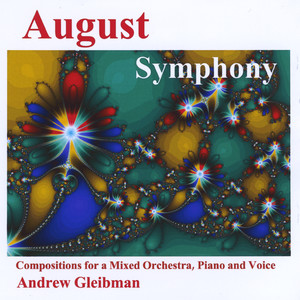
August Symphony: Large Symphony-Concerto for Vibraphone, Piano, Harpsichord, Human Voice and String Orchestra
- 流派:Jazz 爵士
- 语种:英语
- 发行时间:2008-01-01
- 类型:录音室专辑
- 歌曲
- 时长
-
August Symphony
简介
Compositions for a Mixed Orchestra, Vibraphone, Piano, Voice and Harpsichord Professor Junpei Sekino has kindly permitted me to print some of his beautiful Fractal Art images on the jewel cases of my music albums. Although the images are computer-generated, I find a striking emotional association between them and my music, which is almost purely improvisational! Without any attempt to explain this, I am inviting the listener to observe these images and experience these associations. The following info is printed on the jewel case tray of this album: AUGUST SYMPHONY (duration: 45 min) All parts of the symphony are extracted from a single free improvisation, happened one August night 1. Introduction. 2. Intermezzo with Bells Solo. 3. Prelude. 4. Slow Meditation in Atonal Colors. 5. Awakening. 6. Meditation with Harpsichord Solo: The Psychology of a Harpsichord. 7. Finale ATONAL MEDITATIONS (duration: 33 min) (The following pieces are also presented in a special album, see album "Atonal Meditations") 8. WAVES ARE DANCING. Symphonic Fantasy with Sea Waves Playing Super-Virtuoso Party 9. SPRING PRELUDE to the Impossible Scherzo 10. IMPOSSIBLE SCHERZO. Super-Virtuoso Prestissimo for Piano, Impossible for a Human Performer 11. MAGIC GARDEN. Andante Cantabile with Sirens and Heartbeat 12. STRANGE LITTLE ANIMAL. Virtuoso Etude-Dance for Tail, Paws and Piano 13. MORNING IN A PARIS SUBURB. Symphonic Fantasy. Adagio Moderato with Bells and Reflections 14. TWO JAZZMEN. Virtuoso Allegro Agitato for Two Pianists Teasing Each Other Style: Classical-contemporary atonal compositions with elements of impressionism and expressionism. Mood: Philosophical, ironic, tragic, calm, very emotional, excited, observational, playful. Instruments, applied using a computerized music studio: Mainly traditional for a symphonic orchestra. The piano party sometimes involves sonoric and super-virtuoso elements. Influences: Scriabin, Shostakovitch, Rachmaninoff, Prokofiev, Debussy, Ravel. Meditations and Esoterica. Composer and Performer: Andrew Gleibman Fractal Art image: Courtesy of Junpei Sekino Bar-code The following explanation is printed on the inner side of the leaflet: The Art of Improvisation and Modern Music Many great improvisers are known in music history. Bach, Mozart, Beethoven, Paganini, Liszt, Rachmaninoff... It is hard to know whether a small or a large part of their improvisation activity was published in the form of music notes. A musical performance is playing ON an instrument, according to a previously composed plan, while an improvisation is playing WITH an instrument, just like a small child plays with its voice. The child tries and admires the sounds without any plan, sometimes discovering their features which only this child can conceive. The art of improvisation is more ancient than the art of composition. The most perfect instrument in the world -- human voice, and many artificial instruments have appeared long before the invention of music writing. Paradoxically, the epoch of Renaissance caused a decline of the improvisation culture, which was developed during millenniums. Musical writing has ousted the improvisation just like a manufacturer has ousted the creative trade of an artisan. In order to understand what was lost in this ousting, imagine, for a moment, that the art of oil-painting would be entirely ousted by the art of gravure! Today the art of improvisation is retained in a few music genres including jazz. The interest towards a musical improvisation is growing. Computerized instruments are used for storing, encoding and editing the performance of the improvisers. All the presented compositions are extracted from the original author’s improvisations on a Rolland piano instrument, connected to a computer. This is similar to tape-recording. Some new expressive elements are obtained from the stored improvisations by re-timing, re-orchestration, re-articulation, re-arrangement etc. The computer performs the music according to the scripts created and stored in this way. Some pieces contain super-virtuoso elements that a human musician cannot perform. Other pieces retain unchanged the original mood of the improviser, related to his philosophy and reflection of reality. On the physical CDs, the track titles are color-printed on a white background.




